A Look Back at a Stunning Show in 2005
The Depth & Excellence of the Salvador Dalí Exhibition
at the Philadelphia Museum of Art Was Astounding!
at the Philadelphia Museum of Art Was Astounding!
Commentary on the exhibition by Gerry Dawes.
Spanish Wine Dinners Featured at
Restaurant Associates Museum Restaurant
During the Exhibition
Postscript on Catalan Super-Star Chef Ferran Adrià of elBulli.
Restaurant Associates Museum Restaurant
During the Exhibition
Postscript on Catalan Super-Star Chef Ferran Adrià of elBulli.
Dalí Museum, Figueres (Girona).
Those "knobs" (as described by one travel writer) on the building
are representative of a typical style of Catalan bread called pa de crotons.
Gerry Dawes©2004
Those "knobs" (as described by one travel writer) on the building
are representative of a typical style of Catalan bread called pa de crotons.
Gerry Dawes©2004
The depth and excellence of the Advanta-sponsored Salvador Dalí exhibition at the Philadelphia Museum of Art, which ran from February 15 - May 15, 2005 was nothing short of astounding.
Dalí Gala 2005 - Philadelphia Museum of Art
Gerry Dawes©2005
Dalí Gala 2005 - Philadelphia Museum of Art
Gerry Dawes©2005
Although I have travelled in Spain for more than 40 years, visited Dalí's incredible casa-museo on the lovely cove at Port Lligat (Girona), his over-the-top museum in Figueres (his birthplace) and Gala's castle at Pubol, none of that prepared me for the depth, quality and evocative power of this exhibition.
Dalí's House, Port Lligat (Girona)
Gerry Dawes©2004
Port Lligat cove, From above Dalí's house
Gerry Dawes©2004
In the past, I tended to dismiss Dalí as a very talented, very difficult-to-understand surrealist and a mad publicity hound who lived up to André Breton's anagram "Avida Dollars." But, after seeing the 200-piece Philadelphia exhibition twice (and partially at least three-four more times), I am convinced that Dalí--dead since 1989 and long-since stripped of the smoke screen of his outrageous publicity-seeking antics--was the real deal, a unique talent and one of the greatest artists ever.
Dalí, Barcelona
Gerry Dawes©2004
Don't let all those photos of a wild-eyed lunatic fool you. Dalí was a tormented genius and like many of the inhabitants of his native Empordá, no doubt was affected for days on end by the tramuntanas, the wild cyclones in northern Cataluña which not only bend trees and grape vines, sculpt rocks and leave beaches and plains swept clean, they seriously torque the minds of the region's inhabitants, leaving them just a little loco. These wild winds have even been known to have toppled a train. In Dalí's case, the wind doesn't quite explain everything, because he was also infected with a world-class locura (madness) that manifested itself in often outrageous social behavior, but his manias were also the driving force behind a phenomenal artistic talent.
Dalí, Barcelona
Gerry Dawes©2004
But, undeniably a genius Dalí was, the likes of which we have never seen in art. He was endowed with a prodigious technical talent--equal to that of any of the great masters (Velasquez, Goya, Zurbarán, Bosch) that one sees in the Prado--along with vision, originality and the ability to project his deepest psychological demons onto the medium like no one ever has (not even the great Hieronymus Bosch could equal Dalí in such visions). In a mano a mano with Picasso, Dalí would likely win out.
Picasso, Dalí, Miró.
In this picture in a Barcelona tourist shop, Picasso dominates,
but after the Dalí exhibition in Philadelphia, one wonders if it should be the other way around.
In this picture in a Barcelona tourist shop, Picasso dominates,
but after the Dalí exhibition in Philadelphia, one wonders if it should be the other way around.
Gerry Dawes©2004
In the Philadelphia exhibition, the haunting, unforgettable Portrait of My Father, a picture of Dalí's imposing, overbearing father dressed in a heavy black bourgeois clothes dominating the wildly colorful backdrop of the legendary Costa Brava village of Cadaqués (where the Dalí family spent their summers) and the lovely impressionistic Lane to Port Lligat with View of Cap Creus, both painted in 1921, are alone enough to establish Salvador Dalí as an artist (at 17!) with a major talent. In 1924, at 20, Dalí's Portrait of Luís Buñuel is further proof, as are another powerful Portrait of My Father and, in 1925, the compelling Figure at a Window (Dali's sister Ana María gazing out the window, painted from behind).
The same goes for several other portraits painted in 1925 and Woman at the Window at Figueres, painted the following year (1926). Also in 1926, with The Basket of Bread, Dalí showed he could paint still-lifes as well as Velàsquez, Francisco de Zurbarán and the great 18th-century master of bodegones, or still lifes, Luís Meléndez.
Then, in 1929, began an incredible series of psychologically charged and quite disturbing surrealist paintings (they gave André Breton nightmares) that are among Dalí's most famous works: The First Days of Spring, The Great Masturbator, The Enigma of Desire and The Accommodations of Desire, followed by several pornographic drawings, the castration nightmare of William Tell (1930), the erotically charged The Font (1930) and his famous The Persistence of Memory (with the melting watches).

"My Wife, Nude, Contemplating Her Own Flesh Becoming Stairs,
Three Vertebrae of a Column, Sky and Architecture, 1945
Courtesy Philadelphia Museum of Art
There are a number of paintings in the Philadelphia exhibition from the period when Dalí was obsessed with the legend of William Tell, a metaphor for his relationship with his domineering father, and, even more so, there are numerous riffs on the Jean-Françoise Millet's The Angelus (1857), both of which were deeply imbedded with a castration complex according to Dalí's "paranoic-critical" way of seeing the world. In 1935, he painted the classical, powerful Angelus of Gala, which depicts his muse and wife, Gala, in a brocade jacket simultaneously facing the viewer with a version of the Angelus on the wall behind her and from the back showing the design of the brocade jacket (on the back of her skirt are wrinkles that look like a large hand on her ass, undoubtedly one of Dalí's "in" jokes). So important are Dalí's Angelus paintings that The Architectonic Angelus of Millet was chosen as the cover for the Philadephia exhibition catalogue.
Much as I would like to, I won't go through the whole catalogue here, but by the end of the collection, when you see Dalí's later religious paintings--Gala as the Madonna of Port Lligat, The Christ of Saint John of the Cross, Nuclear Cross, Crucifixion (Corpus Hypercubicus) and Ascension--you realize that this wild mind was the driving force behind one of the greatest painters in history and that you have to come back and see this mystical exhibition again before it disappears forever.
Suffice to say that it takes a good two hours just to peruse the incredible works in this collection, which was curated by Dalí expert Dawn Adis and by Michael R. Taylor. After lingering fascinated by the whole show at the gala opening, I realized I had barely scratched the surface, but, because I had a consulting gig at the museum with Restaurant Associates (set up by my friend, Dana Madigan of R.A.), I was lucky enough to see the exhibition twice. I designed Spanish regional-themed wine dinners at the Restaurant Museum during the exhibition and spoke about Spanish food and wine at the dinners, so I got to see the exhibition several times. That and the half dozen books I bought on Dalí allowed me to begin to understand this extraordinarly complex artist. (My participation at these events was pre-destined; since 2002, I had been wearing on my lapel a Dalí melting watch pin--like the ones you see at the beginning of this piece-- that I bought in Barcelona
long before I heard about this show.)
long before I heard about this show.)
Courtesy Philadelphia Museum of Art
From Dalí's Ouefs Sur la Plat (Fried Egg on the Plate without the Plate), we may be seeing a painting that could have inspired Catalan super-star chef, Ferran Adría, to pass over into a new dimension of food with such dishes as a mango "egg yolk" served on a Chinese spoon, ravioli de mango, melón caviar (a ringer for samon caviar, made from melón puree dropped into a calcium chloride solution), spaghetto de parmesano (two yards plus of spaghetto made from Parmesan cheese), etc., all dishes that Dalí would have understood instantly.

Mango "egg yolks," El Bulli by Ferran Adrià
Gerry Dawes©2004
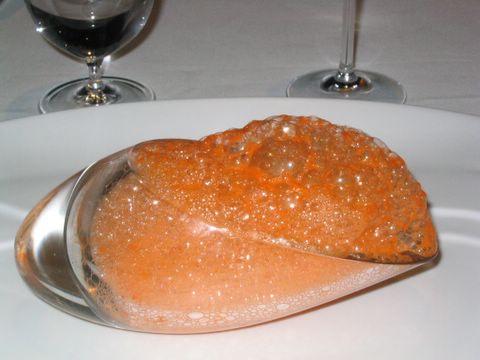
The famous "espuma de zanahorias," carrot foam, featured in a New York Times
cover story about Ferran Adrià and El Bulli.
Gerry Dawes©2004

Melon "Caviar" - El Bulli
Gerry Dawes©2004
Philadelphia Museum of Art Friday night Dinner Series celebrating the Salvador Dali exhibition at the Museum, Philadelphia, Pennsylvania.Featured Speaker on the Cuisines & Wines of Spain:
Gerry Dawes
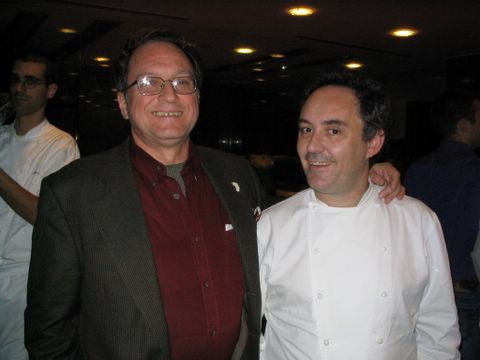
Gerry Dawes with Ferran Adrià of El Bulli at Cala Montjoi,
which is a short distance for Cadaqués and Dalí's home at Port Lligat.
George Semler©2004
George Semler©2004
February 18 (Catalan Cuisine & wines)
March 11 (Book and Cook Catalan Dinner with author Colman Andrews
March 11 (Book and Cook Catalan Dinner with author Colman Andrews
speaking on Catalan Cuisine and GD on Catalan wines)
March 18 (Basque Country Cuisine & Wines with Executive Chef Santi Zabaleta of Washington, D.C.'s top-rated La Taberna del Alabardero)
April 22 (Food and Wines of Valencia & the Spanish Levante)
May 13, 2005 (Castilian Cuisine & the Greatest Red Wines of the Ribera del Duero).
March 18 (Basque Country Cuisine & Wines with Executive Chef Santi Zabaleta of Washington, D.C.'s top-rated La Taberna del Alabardero)
April 22 (Food and Wines of Valencia & the Spanish Levante)
May 13, 2005 (Castilian Cuisine & the Greatest Red Wines of the Ribera del Duero).
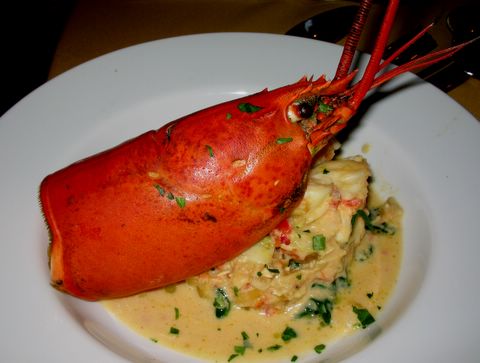
Dalí-inspired lobster dish by Chef Tracey Hopkins,
Museum Restaurant, Philadelphia Museum of Art
Gerry Dawes©2005
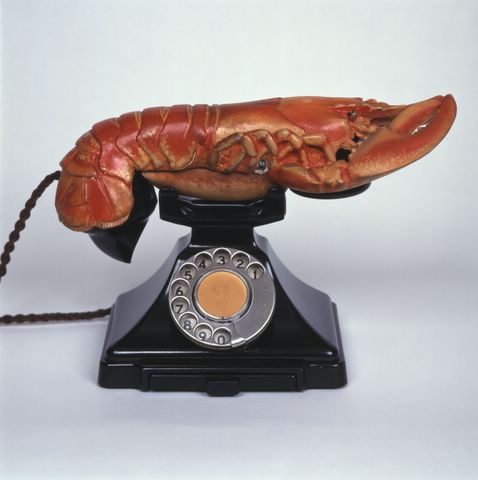
Lobster Telephone, 1936, Chichester, West Sussex, The Edward James Foundation
Courtesy Philadelphia Museum of Art
Postscript
At every stage of his career, even at his most commercial, Dalí showed his unique, singular talent and creative genius. Few artists consistently break the mold and few still can invent entirely new ways of seeing life, death, love, sex, childhood (and adult) fears and the infinite depths of the psyche and can paint them as powerfully with such emotional impact married to such artistic and technical ability.
* * * * *









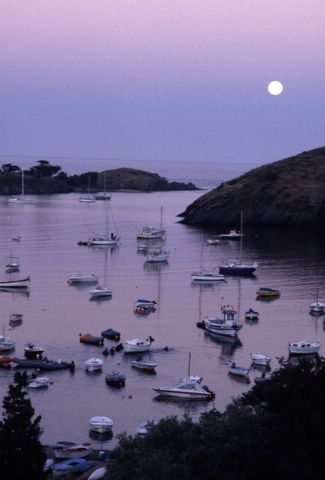




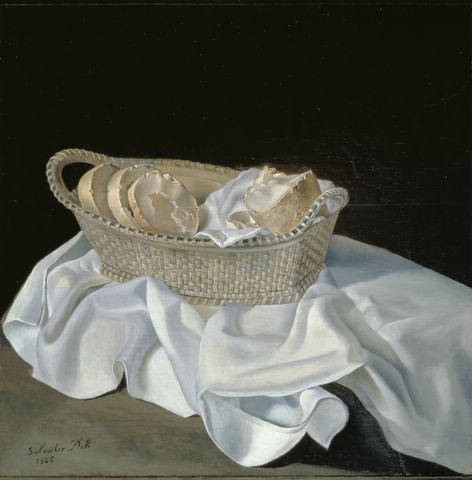











Well done on a great blog Blogger. I was searching for information on vintage posters and came across your post Salvador Dalí Exhibition in Philadelphia - not exactly what I was looking for related to vintage posters but very interesting all the same!
ReplyDeleteI think I've found a search engine with a sense of humor - I was actually looking for articles on how to cook rice, and here I am on a site called Salvador Dalí Exhibition in Philadelphia. There's probably an electronic explanation for this and I have enjoyed the experience, so no harm done. Have a nice day Blogger - if that's your real name :0)
ReplyDeleteHi, I´d like to introduce you to my blog. Pop up as often as you feel like.
ReplyDeleteSpanish language schools in Spain
Real, sincere comments on my blog posts are much appreciated, however, these cheap attempts at advertising one's product or services are just low-rent. Where do you all get the time to do this?
ReplyDelete